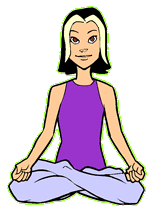YOGA ACTIVITY CARD
Parts of the Body Worked

Upper & Lower Legs

Heart & Lungs

Arms

Wrist & Forearms

Shoulders & Neck

Chest & Back

Abs

Hips & Butt

Knees & Ankles

Before you begin to relax your mind and body, make sure you suit up properly by wearing comfortable clothing that won’t get in the way of your stretching. T-shirts, shorts, sweats, and tank tops are all great to wear for yoga because their fabric is movable and breaths easily. Jeans are definitely out!
Gear Up
You’ll need to wear comfortable clothing that won’t get in the way of your stretching. T-shirts, shorts, sweats, and tank tops are all great to wear for yoga because their fabric is movable and breaths easily. Jeans are definitely out!
Bare feet are ideal when you practice yoga, both for the traction they give you for standing poses, as well as the workout your feet will get!
One of the most important things you will need is a yoga or exercise mat to use during seated or floor postures. Don’t worry if you don’t have a special mat, use a firm pillow or folded up blanket—they work just as well.
Play it Safe
It’s important to make sure your muscles are warmed up before you begin your yoga routine. Never force your body into a posture or try to go beyond your limits—you could strain your muscles. Using the correct form is also key to getting the most out of your yoga experience, so get into a class that’s right for you (whether you’re a beginner or an expert). And, don’t be afraid to ask your teacher for help! Learning the correct way to do each pose is important for overall mind and body development.
Feelin’ stiff or sore? If you are, you’ve overdone it! If you’re just getting into yoga, it’s important to start off slowly. Since yoga is not a competitive sport, your progress may be slow, but with time your body will become more flexible and you’ll be able to achieve more difficult poses.
Interested in giving yoga a try, but not sure where to find classes in your area? It’s important to find a class that you feel comfortable in, and has an experienced teacher. Try asking friends and family members if they know of a good place, or check out your local YMCA, county recreation centers, and fitness clubs—they sometimes have classes for all ages and skill levels. Also, don’t forget about your local library—there you can find more information on yoga itself, as well as magazines or books that may have a listing of classes in your area.
The Bell Game
What You’ll Need:
- An empty space
- A bell
- A group of friends or family members
How to Play:
- Start by getting everyone to sit in a circle with their legs crossed.
- Pick one person in the group to be the leader.
- Place the bell on the floor in front of the leader.
- The leader stands up, picks up the bell carefully without letting it ring.
- The leader sits the bell down in front of someone else in the circle without letting it ring.
- Now that person is the new leader and they have to stand up and pass the bell off to someone else in the circle without letting it ring.
- Keep going around the circle until everyone has had a turn—see how long you can keep going without ringing the bell.
This game is a great way to work on concentration and body control. So, grab a group of friends (and family members too) and see if you can keep the bell from ringing!
How to Play
Did you know that yoga has been around for more than 5,000 years? Today, you see lots of super stars and athletes practicing yoga, but it’s a great activity for anyone! No matter what other activities you participate in, yoga can strengthen your abilities by increasing flexibility, staying power (endurance), and your ability to focus.
Lots of physical activities build your muscles and strength, but many times other parts of your body are left out. Because yoga is a full body workout, it can help to check any imbalance in your muscles.
In addition, yoga strengthens, tones, and stretches your muscles, helping to increase your flexibility. If your body is flexible you will be less likely to get injured.
Most yoga practices focus on physical postures called “asanas,” breathing exercises called “pranayama,” and meditation to bring your body and mind together through slow, careful movements. But, there’s more to it than that! Yoga leads to improved physical fitness, increased ability to concentrate, and decreased stress. Yoga is an activity that helps both your body and mind work a little better.
When to Practice
Yoga can fit easily into your schedule—taking 10-15 minutes each day to practice can make a difference (just make sure to wait at least two to three hours after you’ve eaten!). Yoga is a perfect way to chill out and take some time just for yourself! So, set aside a special time each day and relax, release, and rejuvenate!
Where to Practice
Find a quiet spot where you won’t be distracted. Look for a level area that is large enough for you to stretch upwards as well as to the sides for standing and floor positions or stretches.
How to Practice
Always warm up! Plan a well-rounded workout that includes lots of different positions from all of the major muscle groups (arms, legs, abs, back, chest). Most importantly, remember to breathe! It’s a good idea to start with several arm stretches over your head and deep breaths. Inhale when you try upward and expanded movements, and exhale during downward or forward bending motions.
Concentrate on each position—move slowly making controlled movements until you feel your muscles tensing and resisting (you should feel your muscles stretching, not straining). Each pose in yoga is an experiment, so go slowly and listen to your body. Know when you are pushing yourself too hard or need to challenge yourself a little more.
Last but not least, remember to take 5-10 minutes to relax your body at the end of your workout. This will help to prevent sore muscles and is a way to unwind your body.
Ology
If you’re feeling stressed out, meditation can help reduce those stressful feelings and increase your ability to remember things more clearly. Sometimes when the pressure is on, yoga teaches that the energy center (chakra) of your brain takes a time out. This means you could forget things like what math problems you have to do for homework, or where you are supposed to meet your friends after school. So, before you panic—close your eyes, take a deep breath, and relax. It does your body (and mind) a lot of good!
Many yoga experts believe each person has seven major energy centers called chakras and 42 lesser ones that help to balance the body. The first begins at its base of the spine moving up to the seventh at the top of the head.
Different yoga types and positions focus on different chakras. A color, body system, gland, and nerves are associated with each chakra.
Fun Facts
The word yoga comes from an ancient language and means yoke or unite—to bring together your body, mind, and spirit.
A “yogin” is a male student while a “yogini” is a female student.
Many yoga poses are based on animals and the different postures they do in nature.
More than 6 million people practice yoga including Madonna, Kareem Abdul Jabar, and Michelle Pfeiffer.
- Page last reviewed: September 14, 2017
- Page last updated: September 14, 2017
- Content source:



 ShareCompartir
ShareCompartir